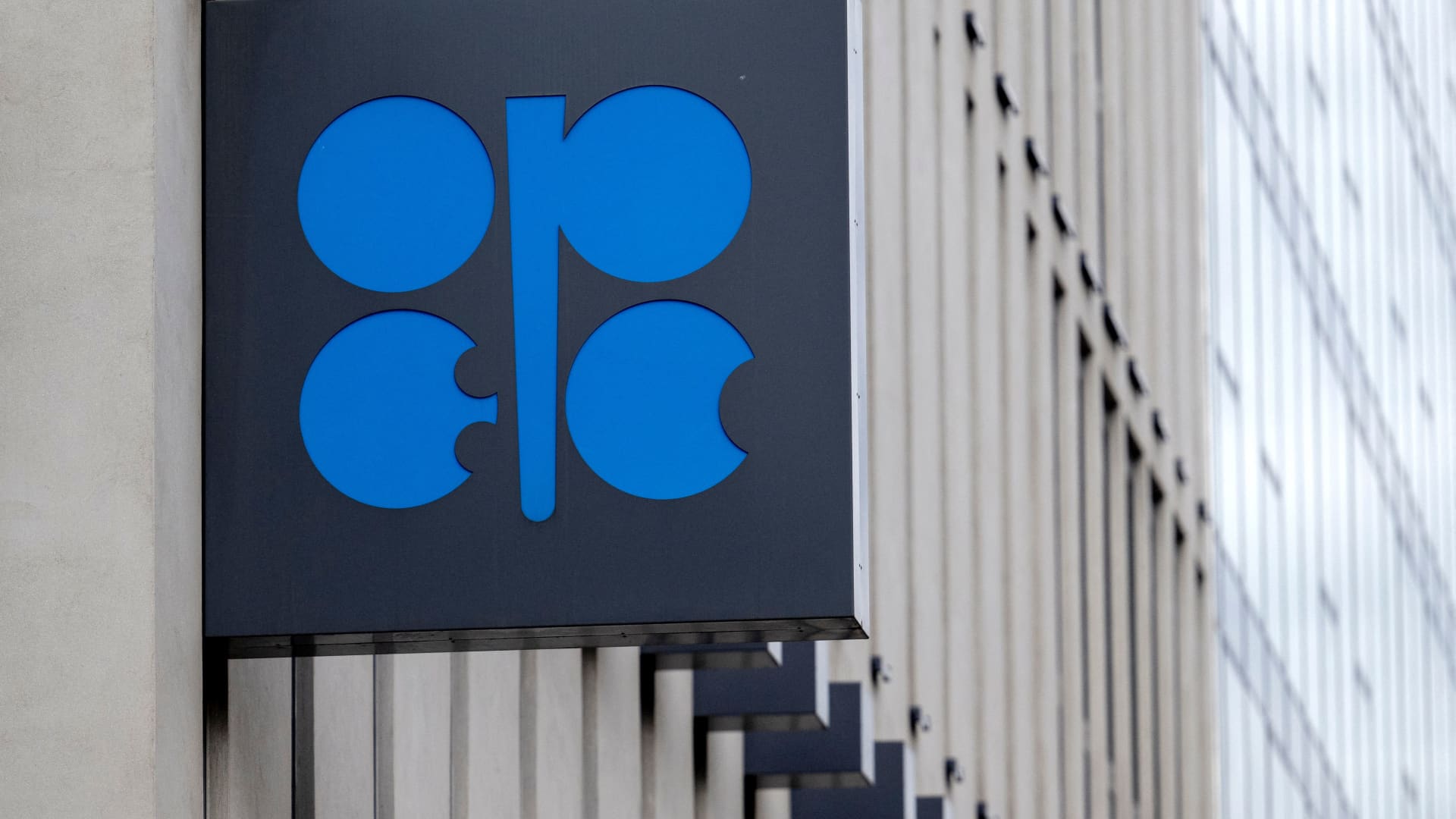OPEC+ just made the Fed’s job more complicated. Here’s why they did it — and what could be next

The logo of the OPEC is pictured at the OPEC headquarters on October 4, 2022. In October last year, the oil cartel announced its decision to cut output by two million barrels per day.
Joe Klamar | Afp | Getty Images
Several OPEC+ members are set to tighten global production by an additional 1.16 million barrels per day until the end of the year, further burdening central bank efforts to curtail global inflation — but critically protecting the alliance’s broader output strategy from political pressures.
Washington has stepped in to criticize Sunday’s announcement where eight OPEC+ producers — including group leader Saudi Arabia and key allies Kuwait and the UAE — said they would remove more than a combined 1 million barrels per day from global oil markets, as part of an independent initiative unlinked to the broader OPEC+ policy.
This adds to Russia’s existing intentions to trim 500,000 barrels per day of its own production from February output levels, now until the end of the year — bringing the combined voluntary cuts of OPEC+ members in excess of 1.6 million barrels per day.
“We don’t think cuts are advisable at this moment, given market uncertainty — and we’ve made that clear,” a spokesperson for the National Security Council said, according to Reuters.
U.S. President Joe Biden’s administration has repeatedly lambasted the OPEC+ group for its production cuts, citing the inflationary toll on households and flinging accusations of camaraderie with sanctions-struck Russia. Curbs in production lead to smaller supply, causing higher prices at the pump in importing countries which then provides a boost for headline inflation figures.
Relations devolved into a war of words with OPEC+ chair Saudi Arabia at the end of last year, when the oil group agreed a 2 million barrels per day cut until the end of 2023 — a decision upheld at ministerial and technical committees since.
One such technical council, the OPEC+ Joint Ministerial Monitoring Committee concluded on Monday with a statement that acknowledged the voluntary cuts, making no mention of a broader change in formal production policy.
Referring to the voluntary cuts, the OPEC Secretariat said they represent “a precautionary measure aimed at supporting the stability of the oil market.”
The JMMC will next convene on June 4, with a full ministerial meeting to follow.
Formal group action is arguably no longer required, with front-month June Brent futures prices up by $4.44 per barrel from the Friday settlement to $84.33 per barrel at nearly 10 a.m. London time. Some analysts now warn of prices soaring to $100 per barrel, while Goldman Sachs could drive up Brent forecasts by $5 per barrel to $95 per barrel for December 2023.
“The anticipated increase in oil prices for the rest of the year as a result of these voluntary cuts could fuel global inflation, prompting a more hawkish stance on interest rate hikes from central banks across the world. That would, however, lower economic growth and reduce oil demand expansion,” said Victor Ponsford of Rystad Energy in a research note.
Tamas Varga, of oil broker PVM, flagged the broader political risks of the organized voluntary cuts, telling CNBC that headline inflation should rise faster than anticipated.
“But central banks might not deviate from the course of slowing down the hike in borrowing as their views are chiefly shaped by core inflation figures, which will not be as much affected by stronger oil prices as headline data,” he said.
“The voices of the proponents of the NOPEC bill in the US Congress will also get louder and they will accuse OPEC+ to use oil as a weapon. The step is unreservedly bullish, for now macro worries are overtaken by supply concerns. The move will also lead to further souring of the Saudi-US relationship.”
The NOPEC — No Oil Producing and Exporting Cartels— bill refers to proposed U.S. legislation that would open OPEC+ countries to potential antitrust legal action.
The U.S. can attempt to combat price hikes by releasing further volumes from its Strategic Petroleum Reserves — with one anonymous OPEC+ delegate saying that Washington has encumbered its fight against inflation by blocking global access to Venezuela and Iranian volumes, while EU nations likewise refrain from Russian purchases out of solidarity with the invaded Ukraine.
OPEC+ delegates have previously also found fault with western nations’ windfall taxes on energy companies — which they claim received no consistent support when WTI futures traded in negative territory in April 2020 — and with the accelerated shift toward renewables that has reduced hydrocarbon investments without producing sufficient alternative green fuel to fully meet consumer demands.
Spare capacity has been at the heart of recent OPEC+ pronouncements, with the group stepping in to protect the appeal of stable return for long-term investments in oil projects. Nearly all of the countries participating in the recently-announced independent cuts possess additional capacity.
One anonymous OPEC+ source said discussions to coordinate further independent cuts gained traction toward the end of last week, when volatility in the banking sector following the failures of several U.S. and Swiss lenders eroded investor confidence in more historically volatile assets, such as oil. OPEC+ delegates have previously expressed that the oil impact of the banking turbulence would be short-lived, with longer-term questions lingering over the looming demand of a reopening China, the world’s largest consumer.
“What happened to the oil prices over the last three weeks was nothing to do with oil factors, it was everything to do with the banking crisis, and the fears that brings with it. We also had a huge, huge increase in [the] short market, and that is something that OPEC are very keen to stomp out,” Amrita Sen, co-founder and director of research at Energy Aspects, told CNBC’s Dan Murphy.
Investors generally assume short positions when they expect market or price declines.
“I do believe, if the market overtightens, or exogenous issues or shocks fade, they will reverse this cut along the line. So this isn’t set in stone for the rest of the year, but very clearly defending a floor.”
Voluntary production moves are easier to agree and unwind without staining domestic or external OPEC+ politics. Such cuts have previously been accepted by the group, provided they aligned with the spirit of existing OPEC+ policies — but they have typically expressed the initiative of a single country, barring temporary Saudi-Kuwaiti-UAE reductions organized during the Covid-19 pandemic.
A coordinated gesture of Sunday’s scale effectively creates a second, unofficial agreement on top of the existing formal OPEC+ strategy — one that does not command formal commitments and can be more readily defended when individual oil ministries face pressures from their own governments or state oil companies to increase output and short-term revenues. Independent cuts also bypass the need for unanimous OPEC+ member approval and tentatively avoid external accusations of organized anti-consumer behavior.
But the gesture will not bridge the growing political rift between OPEC+ kingpin Saudi Arabia and the Biden administration, whose influence has been increasingly supplanted by China in the Middle East. In the past month, Beijing brokered a resumption of relations between arch-rivals Tehran and Riyadh, with Saudi Arabia also taking steps to join the China-led Shanghai Cooperation Organization as a dialogue partner.
“[The organized voluntary cuts] certainly would play into the narrative that the U.S. is losing its influence in the region to either influence the actions of core OPEC producers like Saudi Arabia and the UAE, which have traditionally been client states of the U.S.,” Andy Critchlow, EMEA head of news at S&P Global Platts, told CNBC.
“You can’t really look at this in isolation from the wider geopolitical situation in the Middle East, which is seeing these core oil producers shift closer to China, shift much closer to Russia. You know, they like operating in this multipolar world, instead of being completely tied to U.S. dependency.”










